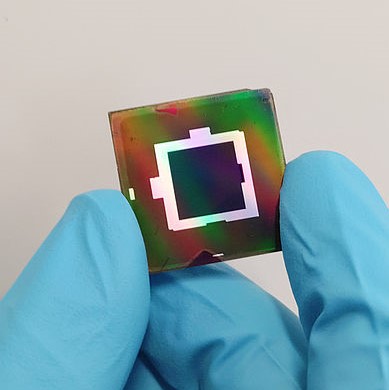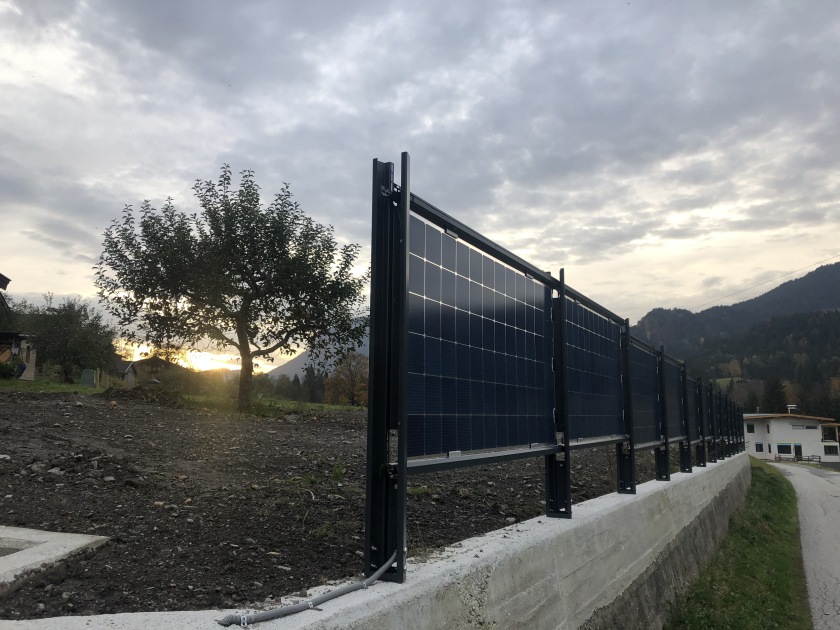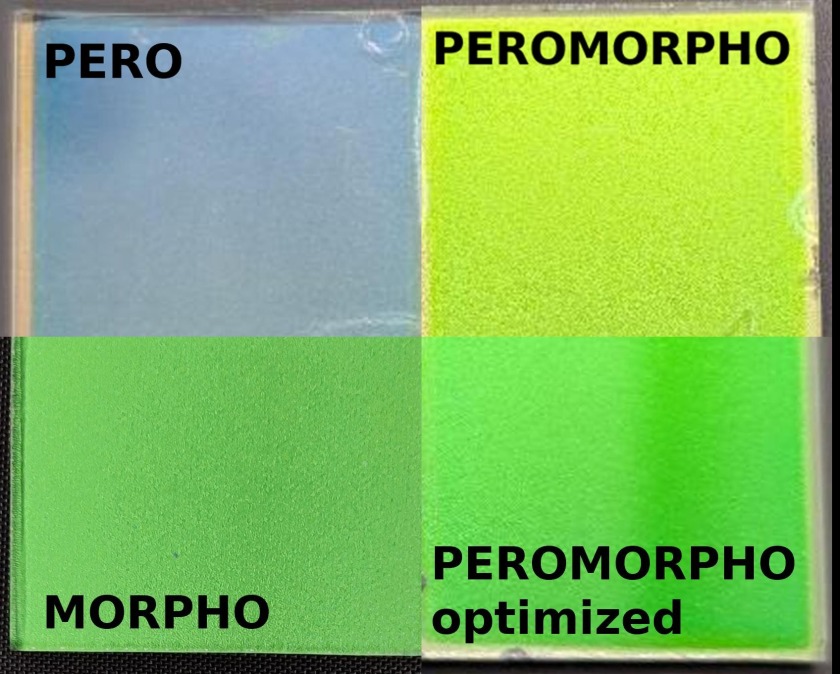Department Optics for Solar Energy
The Department
At the Department Optics for Solar Energy (SE-AOPT) we work on experimental and numerical optics in and for photovoltaic devices. From an optical point of few the Sun is a challenging energy source: solar energy devices have to be optimized for a broad spectral range and for a light source changing the illumination direction during the course of the day and the year with varying shares of direct and diffuse irradiance.
This requires advanced optical concepts ranging from “conventional” ray optics to nanophotonic concepts and spectral conversion. Our reseach brings together experimental expertise—mainly nanoimprint lithography—and optical simulations. Our current research topics include light management in perovskite solar cells and perovskite/silicon tandem solar cells, antireflective microstructures and energy yield calculations.
Currently, the department is – amongst others – member of the HySPRINT Photovoltaic Lab, participates in the Helmholtz Einstein Berlin Research School in Data Science (HEIBRiDS) and is a leading member of the Berlin Joint Lab for Optical Simulations for Energy Research (BerOSE) between HZB, the Zuse Institute Berlin (ZIB) and the Free University Berlin
How can optics further improve solar energy?

In a collaborative effort, our department head Prof. Dr. Christiane Becker and deputy Dr. Klaus Jäger brought together 27 experts from 9 countries for a review on Optics for Solar Energy. The article covers all relevant aspects:
🔹 Ecodesign – using abundant optical materials 🌍
🔹 Employing Luminescence to further boost efficiency ✨
🔹 Light management in multi-junction solar cells 🌈
🔹 Reshaping the solar spectrum 🌞
🔹 Thermal management of Photovoltaic modules 🌡️
🔹 Accurate energy yield prediction 📈
🔹 Color and aesthetics of PV modules 🎨
The review was published in Advances in Optics and Photonics and is also available as a preprint. Our colleague Dr. Antonia Rötger wrote a summary.
Research topics
Light management in perovskite/silicon tandem solar cells

A textured perovskite/silicon solar cell. Picture: J. Sutter / HZB.
Perovskite/silicon tandem solar cells are a promising concept to surpass the efficiency limit of silicon solar cells, the most widespread solar cell technology. Tandem solar cells allow to harvest the broad solar spectrum more effectively, because the the energy of short-wavelength photons can be utilized more efficiently.
Light management aims to minimize optical reflection and transmission losses in solar cell devices. In order to achieve this, we build solar cells with one- to three-dimensional photonic nano- and/or micro-structures, which are specifically tailored for the respective device structure and its wavelength regime. In addition, the influence of the optical structures on the electronic material properties as well as the interfaces are always taken into account.
In collaboration with Steve Albrecht's Department Perovskite Tandem Solar Cells and the silicon solar cell group at PVcomB led by Bernd Stannowski, we managed to build a perovskite/silicon tandem solar cell with 29.8% power conversion efficiency. This was the world record between November 2021 and July 2022.
Key publications
- Tockhorn, P.; Sutter, J.; Cruz, A.; Wagner, P.; Jäger, K.; Yoo, D.; Lang, F.; Grischek, M.; Li, B.; Li, J.; Shargaieva, O.; Unger, E.; Al-Ashouri, A.; Köhnen, E.; Stolterfoht, M.; Neher, D.; Schlatmann, R.; Rech, B.; Stannowski, B.; Albrecht, S.; Becker, C.: Nano-optical designs for high-efficiency monolithic perovskite–silicon tandem solar cells. Nature Nanotechnology early view (2022)
doi: 10.1038/s41565-022-01228-8; Data-doi: 10.5442/ND000009 - Sutter, J.; Eisenhauer, D.; Wagner, P.; Morales Vilches, A.B.; Rech, B.; Stannowski, B.; Becker, C.: Tailored Nanostructures for Light Management in Silicon Heterojunction Solar Cells. Solar RRL 4 (2020), p. 2000484/1-8.
doi:10.1002/solr.202000484.
Open Access (external provider)
- Tockhorn, P.; Sutter, J.; Colom, R.; Kegelmann, L.; Al-Ashouri, A.; Roß, M.; Jäger, K.; Unold, T.; Burger, S.; Albrecht, S.; Becker, C.: Improved Quantum Efficiency by Advanced Light Management in Nanotextured Solution-Processed Perovskite Solar Cells. ACS Photonics 7 (2020), p. 2589–2600.
doi:10.1021/acsphotonics.0c00935.
Open Access (external provider)
Optical optimization of bifacial solar power plants

Bifacial solar modules, which are installed as a solar fence. Picture: K. Jäger / HZB.
Photovoltaic (PV) systems consisting of bifacial solar modules can generate a significantly higher annual energy yield than systems using conventional monofacial PV modules, because bifacial solar modules not only utilize light impinging onto their front, but also illumination onto their rear side.
Bifacial solar cells allow to increase the output power of PV systems at low additional costs and are hence on the march to dominate the PV market soon. In our department we work on optical optimization of bifacial solar panels and hence on decreasing the levelized cost of electricity (LCOE) further. To achieve this we combine advanced optical simulation models with global solar irradiance data using modern computational optimization algorithms.
Key publications
- Tillmann, P.; Jäger, K.; Karsenti, A.; Kreinin, L.; Becker, C.: Model-Chain Validation for Estimating the Energy Yield of Bifacial Perovskite/Silicon Tandem Solar Cells. Solar RRL 6 (2022), p. 2200079/1-12
doi: 10.1002/solr.202200079
Open Access
- Jäger, K.; Tillmann, P.; Katz, E.A.; Becker, C.: Perovskite/Silicon Tandem Solar Cells: Effect of Luminescent Coupling and Bifaciality. Solar RRL 5 (2021), p. 2000628/1-9.
doi:10.1002/solr.202000628
- Tillmann, P.; Jäger, K.; Becker, C.: Minimising the levelised cost of electricity for bifacial solar panel arrays using Bayesian optimisation. Sustainable Energy & Fuels 4 (2020), p. 254-264.
doi:10.1039/c9se00750d
Flexible perovskite solar cells
The fabrication of solar cells on flexible substrates widens the potential application of photovoltaics. The materials employed as flexible substrates and the bending of the devices when they are applied may limit their efficiency when compared to the rigid cells fabricated on tough and highly transparent glass. The application of optimized textures can contribute to minimizing the efficiency losses by, for instance, increasing the light absorbed on the perovskite film or releasing the stress on the cell materials. Moreover, the wide range of materials available to be employed as flexible substrates offers different options for the fabrication of such textures.
In our group, we study the implications of using textured flexible substrates on the solar cell processing and performance, by fabricating and characterizing various textures on different types of flexible materials. The experimental research in combination with advanced simulations aims to also optimize the flexible solar cells according to their application and stack structure.
Key Publications
Rieckhoff, S., Riesebeck, F., Soldera, M., Mayer‐Stillrich, K., Wang, Q., Ruske, F., Lasagni, A.F. and Becker, C., Texture‐Enhanced Mechanical Stability of Transparent Electrodes for Flexible Optoelectronics with Near‐Infrared Response. Advanced Materials Interfaces, p.2400922.
doi: 10.1002/admi.202400922
Links
Multilayer thin-film based color filters for perovskite solar cells

Figure Color appearance for perovskite (PERO), Morphocolor color filter on an absorber (MORPHO), Morphocolor on a perovksite solar cell (PEROMORPHO) and an optimized color filter based on Morphocolor on a perovskite solar cell (PEROMORPHO optimized). The optimized color filter has a lower color distance to the target MORPHO compared to the PEROMORPHO case. Furhter, the loss for PEROMORPHO optimized is reduced in comparison to PEROMORPHO.
For building-integrated photovoltaics (BIPV), aesthetics plays a crucial role alongside module efficiency. To achieve optimal visual appeal, highly efficient interference filters, also known as color filters, are employed. These filters enable vibrant, customized color impressions while minimizing energy losses (~6%). Advanced optimization techniques, including Bayesian optimization and modern AI methods such as Generative Pre-trained Transformer (GPT) models, are utilized to precisely design vivid color aesthetics that maintain high photovoltaic efficiency. With our cooperation partners from Computational Nanooptics at Zuse Institute Berlin, JCMwave and MATH+ we provide designs for colorful and efficient solar cells.
Key Publication
Schaible, J., Winarto, H., Škorjanc, V., Yoo, D., Zimmermann, L., Jäger, K., Sekulic, I., Schneider, P.-I., Burger, S., Wessels, A., Bläsi, B. and Becker, C. (2025), Optimizing Aesthetic Appearance of Perovskite Solar Cells Using Color Filters. Sol. RRL, 9: 2400627. https://doi.org/10.1002/solr.202400627
Simulation of Optical Textures and Multilayerstacks

Figure
Fig1: An example stack used in the simulations, the stack contains a perfectly matched layer (PML) on top used to model the optically infinite space above. A protective glass layer, indium tin oxide (ITO) as the front contact and copper as the back contact. The perovskite absorber layer lies between a hole transport (HTL) and electron transport layer (ETL). It shows a profile of the generated charge carriers.
Solar cell technology has advanced rapidly in recent years. To design an efficent solar cell, different materials are stacked on top of each others.
First varying the thickness, and type of materials of these layers is a main driving force to increase solar cell efficency. A second method is to study the effect of different interface structures between the layers, such as pyramids or sinusoidal bumps on nanoscale range. At SE-AOPT we use state of the art simulation tools to simulate these effects. Enabeling quick calculations without long exhausting trials in the lab.
Simulation of Radiative Recombination
When studying tandem solar cells, effects known as luminescent coupling and photon recycling take place. These happen when emitted radiation is reabsorbed within the solar cell stack, either by a lower bandgap material or the same material, respectively.
Due to a lack of a mathematical models to describe this process, it was only approximated by the use of different auxiliary methods in the past.
At SE-AOPT we work at deriving a model that yields non-degenerate results and fits into the existing simulation framework.


